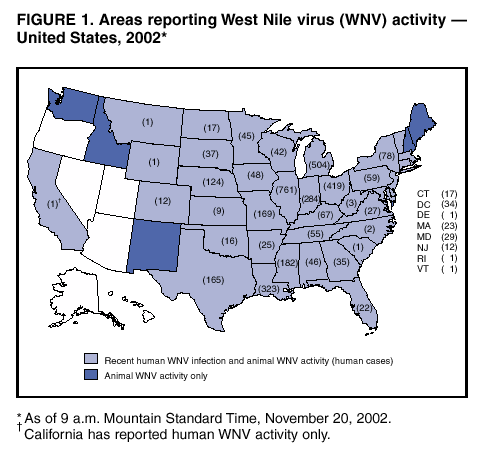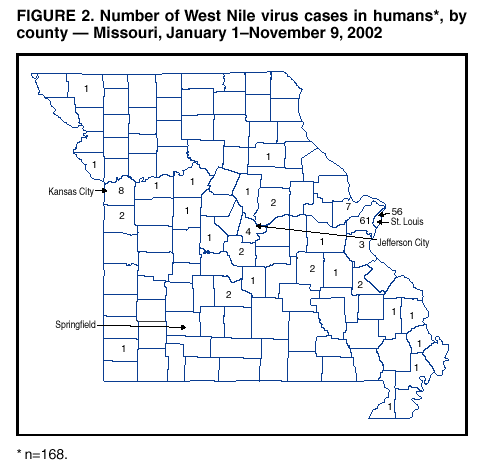 |
|
|
|
|
|
|
|
|
|
|
|
|
|
|
|
|
||||
| ||||||||||
|
|
|
|
West Nile Virus Activity --- United States, November 14--20, 2002, and Missouri, January 1--November 9, 2002This report summarizes West Nile virus (WNV) surveillance data reported to CDC through ArboNET and by states and other jurisdictions as of 9 a.m. Mountain Standard Time, November 20, 2002. United StatesDuring November 14--20, a total of 111 laboratory-positive human cases of WNV-associated illness were reported from Indiana (n=37), Illinois (n=23), Texas (n=17), Nebraska (n=nine), Ohio (n=six), Georgia (n=five), Arkansas (n=four), Florida (n=four), Minnesota (n=three), Maryland (n=one), Massachusetts (n=one), and Tennessee (n=one). During the same period, WNV infections were reported in 90 dead crows and 330 other dead birds. A total of 411 veterinary cases and 25 WNV-positive mosquito pools were reported. During 2002, a total of 3,698 human cases with laboratory evidence of recent WNV infection have been reported from Illinois (n=761), Michigan (n=504), Ohio (n=419), Louisiana (n=323), Indiana (n=284), Mississippi (n=182), Missouri (n=169), Texas (n=165), Nebraska (n=124), New York (n=78), Kentucky (n=67), Pennsylvania (n=59), Tennessee (n=55), Iowa (n=48), Alabama (n=46), Minnesota (n=45), Wisconsin (n=42), South Dakota (n=37), Georgia (n=35), the District of Columbia (n=34), Maryland (n=29), Virginia (n=27), Arkansas (n=25), Massachusetts (n=23), Florida (n=22), Connecticut (n=17), North Dakota (n=17), Oklahoma (n=16), Colorado (n=12), New Jersey (n=12), Kansas (n=nine), West Virginia (n=three), North Carolina (n=two), California (n=one), Delaware (n=one), Montana (n=one), Rhode Island (n=one), South Carolina (n=one), Vermont (n=one), and Wyoming (n=one) (Figure 1). Among the 3,287 patients for whom data were available, the median age was 55 years (range: 1.5 months--99 years); 1,755 (54%) were male, and the dates of illness onset ranged from June 10 to November 4. A total of 198 human deaths have been reported. The median age of decedents was 78 years (range: 24--99 years); 120 (61%) deaths were among men. In addition, 7,612 dead crows and 6,060 other dead birds with WNV infection were reported from 42 states and the District of Columbia; 8,723 WNV infections in mammals (8,710 equines, three canines, and 10 other species) have been reported from 38 states (Alabama, Arkansas, Colorado, Connecticut, Delaware, Florida, Georgia, Idaho, Illinois, Indiana, Iowa, Kansas, Kentucky, Louisiana, Maryland, Massachusetts, Minnesota, Mississippi, Missouri, Montana, Nebraska, New Jersey, New Mexico, New York, North Carolina, North Dakota, Ohio, Oklahoma, Pennsylvania, South Carolina, South Dakota, Tennessee, Texas, Vermont, Virginia, Washington, Wisconsin, and Wyoming). During 2002, WNV seroconversions have been reported in 366 sentinel chicken flocks from Florida, Iowa, Nebraska, North Carolina, Pennsylvania, Texas, and New York City; 4,931 WNV-positive mosquito pools have been reported from 27 states (Alabama, Arkansas, Connecticut, Delaware, Georgia, Illinois, Indiana, Iowa, Kansas, Kentucky, Maryland, Massachusetts, Mississippi, Missouri, Nebraska, New Hampshire, New Jersey, New York, North Carolina, Ohio, Pennsylvania, Rhode Island, South Carolina, South Dakota, Texas, Vermont, and Virginia), New York City, and the District of Columbia. MissouriDuring January 1--November 9, 2002, the Missouri Department of Health and Senior Services (MDHSS) identified 168 persons with laboratory evidence of West Nile virus (WNV) infection; 34 cases were confirmed by CDC on the basis of the plaque-reduction neutralization test, and 134 cases were classified as probable pending CDC confirmation. Five cases were fatal; all five patients had encephalitis. The 168 patients had a median age of 53.2 years (range: 4--92 years); 91 patients (53%) were male. Median age of decedents was 75.6 years (range: 61--88 years). Dates of illness onset ranged from July 31 to October 12. Of Missouri's 114 reporting local public health agencies (LPHAs), 109 (96%) have reported WNV-positive animal tests, representing nearly all geographic regions and human population centers in Missouri (Figure 2). Human WNV cases have occurred among persons from 32 (28%) of LPHA districts; 126 (75%) patients resided in metropolitan St. Louis districts. The metropolitan Kansas City area has recorded eight cases; no human WNV cases have been reported from the Springfield area (Greene County). The elevated WNV incidence rate in the metropolitan St. Louis area, especially within St. Louis city limits (16.1 cases per 100,000 population), is under investigation. Of 134 Missouri WNV cases for which case investigations are completed, 86 (64%) patients recalled being bitten by a mosquito 3 weeks before onset of illness. In addition, 86 (64%) patients reported not using repellent during that time. Patients spent an average of 4.4 hours outdoors per day for leisure and work. Morning (47%) was the time that patients most frequently reported being active outdoors for leisure and work. A total of 58 (43%) patients reported having standing water around their home during the 3 weeks preceding onset of illness. The top four reported sources of standing water were birdbaths, flowerpots, pet watering containers, and tires. MDHSS provides frequent updates on human cases of WNV and activity by county for dead birds and infected horses on its website (http://www.dhss.state.mo.us/WestNileVirus/positives.pdf). Results on specimens submitted for laboratory testing are provided to patient providers, submitting laboratories, and local health departments. MDHSS issues press releases updating case numbers, reminding the public of personal protection measures, and advising elimination of sources of standing water around residences. MDHSS produced a statewide prevention campaign based on the slogan "Don't Let It Bug You," which included posters and brochures distributed to all 114 LPHAs, direct-mail appeals to St. Louis area clergy for increased community awareness of mosquito habitats, television and radio public service announcements, and a toll-free hotline for citizens' questions. Mosquito-control program recommendations, developed by MDHSS are available at http://www.dhss.state.mo.us. The decision to initiate a control program has been left to local municipalities. Additional information about WNV activity is available at http://www.cdc.gov/ncidod/dvbid/westnile/index.htm and http://www.cindi.usgs.gov/hazard/event/west_nile/west_nile.html. Figure 1 Return to top. Figure 2  Return to top.
Disclaimer All MMWR HTML versions of articles are electronic conversions from ASCII text into HTML. This conversion may have resulted in character translation or format errors in the HTML version. Users should not rely on this HTML document, but are referred to the electronic PDF version and/or the original MMWR paper copy for the official text, figures, and tables. An original paper copy of this issue can be obtained from the Superintendent of Documents, U.S. Government Printing Office (GPO), Washington, DC 20402-9371; telephone: (202) 512-1800. Contact GPO for current prices. **Questions or messages regarding errors in formatting should be addressed to mmwrq@cdc.gov.Page converted: 11/21/2002 |
|||||||||
This page last reviewed 11/21/2002
|